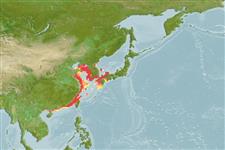Environment: milieu / climate zone / depth range / distribution range
Ecology
Marine; freshwater; brackish; pelagic-neritic; anadromous (Ref. 51243); depth range 0 - 50 m (Ref. 189). Subtropical; 42°N - 21°N, 109°E - 134°E (Ref. 189)
Northwest Pacific: Canton north to Ariake Sound, southwestern Japan, including all of Yellow Sea and off western coasts of Korea. Penetrates over 1000 km up the Yangtze River.
Length at first maturity / Size / Weight / Age
Maturity: Lm ?, range 24 - 27 cm
Max length : 41.0 cm TL male/unsexed; (Ref. 189)
Dorsal
spines
(total): 0;
Anal
spines: 0;
Anal
soft rays: 80. Body tapering, belly rounded before pelvic fins, with 16 to 26 + 25 to 36 = 43 to 61 keeled scutes from isthmus to anus. Maxilla long, reaching to or almost to base of first pectoral fin ray. Pectoral fin with 6 filaments; branched fin rays longer than those of pelvic fin.
Occurs in coastal waters, estuaries and reaching up to middle parts of rivers, apparently able to tolerate freshwater (Ref. 189, 11230). Lives in not really clean water but not really turbid water either (Ref. 12218). Goes to the deep water areas of rivers at night (Ref. 12218). Planktivore (Ref. 12218). Spawns around three times in a lifetime and spawning occurs in between reeds (Ref. 12218). In Ariake Sound, Japan it breeds from May to August, the fishes running about 15 km up the Chikugo River and spawning in freshwater, the spherical eggs floating down and hatching near the river mouth. Its relatively large size makes it a more esteemed food fish than most Coilia. Used in Chinese medicine (Ref. 12166).
Spawn in school (Ref. 205).
Whitehead, P.J.P., G.J. Nelson and T. Wongratana, 1988. FAO Species Catalogue. Vol. 7. Clupeoid fishes of the world (Suborder Clupeoidei). An annotated and illustrated catalogue of the herrings, sardines, pilchards, sprats, shads, anchovies and wolf-herrings. FAO Fish. Synop. 125(7/2):305-579. Rome: FAO. (Ref. 189)
IUCN Red List Status (Ref. 130435)
Threat to humans
Harmless
Human uses
Fisheries: commercial
More information
ReferencesAquacultureAquaculture profileStrainsGeneticsElectrophoresesHeritabilityDiseasesProcessingNutrientsMass conversion
Tools
Special reports
Download XML
Internet sources
Estimates based on models
Preferred temperature (Ref.
123201): 12.3 - 25.2, mean 17.5 °C (based on 218 cells).
Phylogenetic diversity index (Ref.
82804): PD
50 = 0.5001 [Uniqueness, from 0.5 = low to 2.0 = high].
Bayesian length-weight: a=0.00251 (0.00190 - 0.00332), b=3.07 (3.02 - 3.12), in cm total length, based on LWR estimates for this species (Ref.
93245).
Trophic level (Ref.
69278): 3.0 ±0.00 se; based on food items.
Generation time: 3.1 ( na - na) years. Estimated as median ln(3)/K based on 2
growth studies.
Resilience (Ref.
120179): Medium, minimum population doubling time 1.4 - 4.4 years (K=0.35; tmax=5).
Fishing Vulnerability (Ref.
59153): Low to moderate vulnerability (25 of 100).
